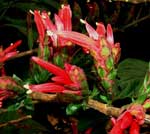|
Metarungia pubinervia;
Red Sunbird Bush; Rooisuikerbekkiebos Article
by Geoff
Nichols
|
You can imagine my
excitement in early April 2000 when a friend by the name of David
Styles phoned me to say he had a specimen of a plant that he had never
seen before. I said bring it round and let’s have a look. He is a keen
member of a group of mildly eccentric
plant nuts, of which I must add; I like to include myself in.
He and Rod
Edwards have during 1999 with
intermittent
help from the likes of the local Ezimvelo KwaZulu-Natal Conservation
Services
Park Warden, Ian Pattrick, and a
band of people like Richard
Boon,
Peter Turner, Isabel Eyeberg, Neil Crouch and Richard Symmonds been
fossicking about in the steep densely wooded slopes of the Krantzkloof
Nature
Reserve adding plants to the already extensive plant list of the
Reserve.
|

|
The real botanists
and experts in the Acanthus Family - Trevor Edwards in
Pietermaritzburg,
Kevin Balkwill in Johannesburg, Brian Schrire and the Kaj Vollesen at
Kew
Gardens in the England helped us to give this plant its real name. The
Latin
species name of pubi – hairy and nervia - nerves or veins is apt
because
under the leaves the main veins are covered in fine hairs. The lag time
in
getting plants identified was cut dramatically by using digital
photography
to send images over the internet to the other side of the world and get
an
answer in hours rather than days or weeks.
The Krantzkloof Nature Reserve is a deep gorge cut through the Natal
Group Sandstone by two main rivers the Molweni and Nkutu, that help
form the escarpment between the coastal plain and the interior inland
of Durban.
Surrounded by a sea of suburbia above, and a semi-formal settlement
below, the Krantzkloof gorges are a life raft for a vast number of
plant species, many rare or endangered. Some are near local endemics,
and one of these,
Brachystelma natalense, is believed extinct except for the area’s last
small
population.
At about 1 500 hectares the gorge system is Durban’s largest remaining
natural area and a unique remnant of what existed a brief 150 years
before
a tidal wave of settlement, suburbia and sugarcane engulfed the
KwaZulu-Natal
coast.
Continuing residential development continues to whittle away at the
natural area, with the greatest impact on grasslands on the gorge
plateaus. Yet
much of the remaining natural area survives because of its difficult
terrain,
and a core area of 584 hectares is protected within the Krantzkloof
Nature
Reserve, which was proclaimed in 1950.
This gorge has yielded surprises over the years and now with the keen
eyes of this band of enthusiasts at least 20 species new to the Durban
Metropolitan Region have been unearthed and amongst this list is the
plant I am going
to describe to you.
How this plant has escaped detection over the
years
will always remain a mystery I have personally walked through the
plants
at least twice in the last 25 years. Probably with my eyes shut because
of the heat and humidity down in the depths of the Gorge!!
There are literally thousands of specimens from relatively large shrubs
of around 4-5 metres tall down to the youngest seedlings and suckers
that develop when a plant is damaged and the stem touches the soil it
roots to form another plant. A KZNCS Game Guard, Eseu Dlamini has
discovered another group of plants, in his patrols through the dense
bush in the Gorge. These plants grow on the south facing slopes of the
gorge in virtually full shade for most of the year.
When we first visited the site to photograph this species with other
“plant nutters” the mature specimens were in full bud and some plants
just starting to flower properly. June and July are the peak flowering
months with seed appearing in late July to August. Ready for the spring
rains to get the
young plants off to a good start.
The normal Metarungia that is in the horticultural trade is Metarungia
longistrobus from the Mpumalanga Lowveld. This species has orange
flowers
at the ends of the branches in May and June.
There is another species from the eastern Cape near East London known
as Metarungia galpinii this species also has orange flowers at the ends
of
branches.

|
Our Durban species has
flowers
that are produced on the upper side of each branch in the same spikes
that
are about the size of a human little finger. The red flowers pop out of
the
spike a little like a snapdragon flower. The primary pollinators of
this
plant are the forest sunbirds like the Grey, Olive and Collared
Sunbirds. Just sitting quietly in the colony these birds can be seen
flitting about from bush to bush feeding. In my own garden in 2007
there is a single flowering specimen where Olive and Grey Sunbirds find
this single plant in a see of concrete covered suburbia. It
forms a dominant undergrowth layer of
plants under the larger forest trees on the rocky scree slopes that are
formed
below the high cliffs in the Gorge.
Another interesting plant amongst the
colony
is the stemless forest cycad – Encephalartos villosus.
|
The walk to these plants is not for the faint
hearted.
It is steep and rocky and I knew I had muscles that I had not used in a
while after our trip.
The plant roots easily from cuttings and once the permits and other
bureaucratic formalities are complete this botanical group will be
making plants available to the public via seed and cuttings.
This effort will be used as a tool for this
cash strapped plant group to boost the funds for developing and
maintaining a herbarium
developed by the locals and housed in the Krantzkloof Reserve to record
the
rich variety of plants found in this gem of gorge right in the middle
of
a huge human settlement that is Durban.
|